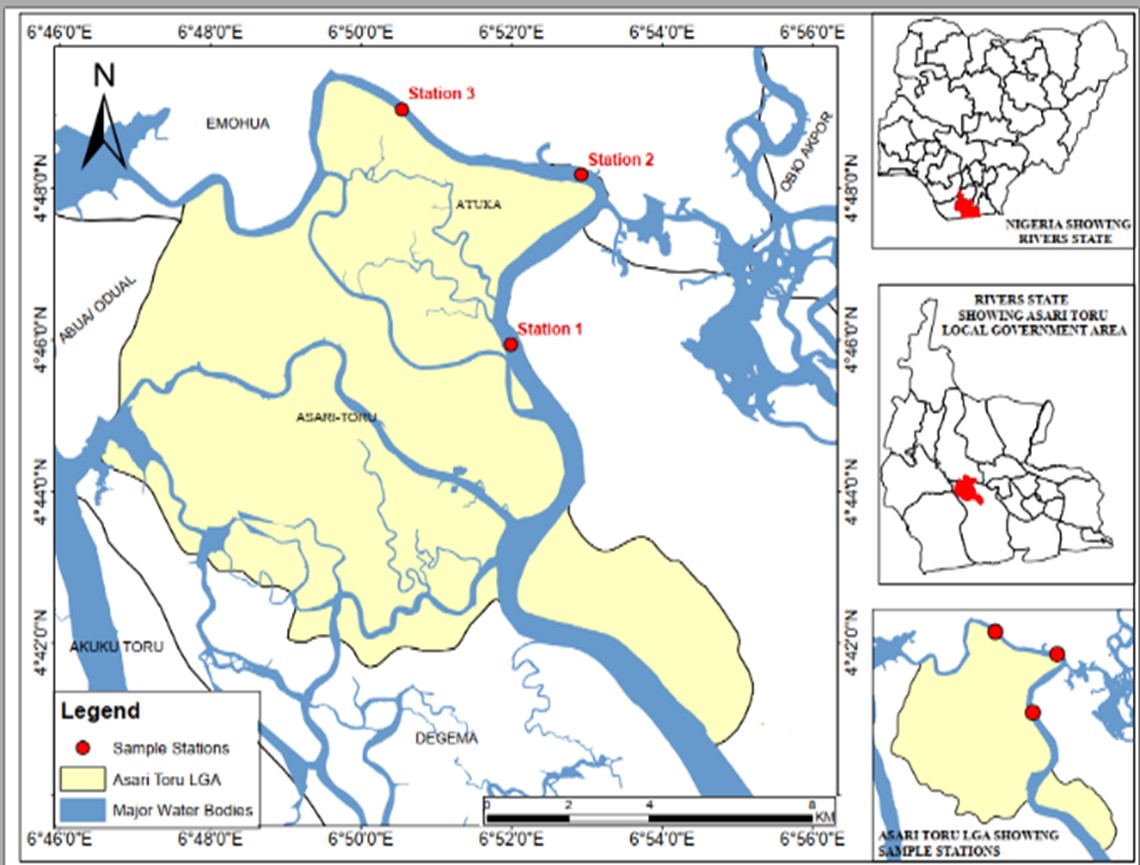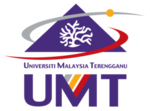DISTRIBUTION OF HADROCHEMICAL PARAMETERS, TOXICOLOGY AND HAZARDOUS ELEMENTS BIOACCUMULATION IN PERIWINKLE (TYMPANOTONUS FUSCATUS) FROM THE NIGER DELTA COAST, NIGERIA
Keywords:
Physicochemical parameters, Hazardous Elements, Niger Delta, BioaccumulationAbstract
The study examined the distribution of physicochemical parameters and toxic metals in the Niger Delta Coast, Nigeria. The shellfish (T. fuscatus), water, sediments, and physicochemical data were collected from three sampling stations over a six-month period. The findings revealed considerable variability in levels of heavy metals and physicochemical features between stations. Station 2 had higher temperature and salinity levels but lower total dissolved solids, pH, biological oxygen demand, and dissolved oxygen. Station 1 had the highest concentrations of Fe, Zn, Cd, Pb, Cu, and As in water and sediment samples, while Station 2 consistently had the lowest concentrations. Station 3 had the highest Fe levels while Station 2 had the lowest Zn values in terms of sediment bioaccumulation. The study found no significant differences (p > 0.05) in all metals in water, T. fuscatus and sediment between stations 1 and 2, except for Cu, which showed slight variation (p < 0.05). In fish, Cu showed slight variation (p < 0.05) between stations 1 and 2, and in sediment, Fe and Cu showed significant differences (p < 0.05) between stations 1. For As bioaccumulation, Station 3 had the greatest concentration, measuring 0.00000123 mg/kg, while both Stations 1 and 2 shared the lowest bioaccumulation at 0.00000058 mg/Kg. Station 3 had the highest Fe bioaccumulation, possibly due to local conditions or iron sources. Higher metal bioaccumulation in these areas may lead to potential environmental and health implications due to their susceptibility to metal pollution. The study suggests that constant assessment and remedial measures are needed to safeguard the aquatic ecosystem in the area.
References
Agwu, E. J., Odanwu, S. E., Ezewudo, B. I., Odo, G. E., Nzei, J. I., Iheanacho, S. C., & Islam, M. S. (2023). Assessment of water quality status using heavy metal pollution indices: A case from Eha-Amufu catchment area of Ebonyi River, Nigeria. Acta Ecologica Sinica. https://doi.org/10.1016/j.chnaes.2023.02.003
Ahmed, A. S., Sultana, S., Habib, A., Ullah, H., Musa, N., Hossain, M. B. & Sarker, M. S. I. (2019). Bioaccumulation of heavy metals in some commercially important fishes from a tropical river estuary suggests higher potential health risks in children than adults. Plos one, 14(10), e0219336. https://doi.org/10.1371/journal.pone.0219336
Ahmed, M. K., Baki, M. A., Islam, M. S., Kundu, G. K., Habibullah-Al-Mamun, M., Sarkar, S. K., & Hossain, M. M. (2015). Human health risk assessment of heavy metals in tropical fish and shellfish collected from the river Buriganga, Bangladesh. Environmental science and pollution research, 22, 15880-15890. https://doi.org/10.1007/s11356-015-4813-z
Akankali J.A., Davies I. C., and Akurokeokiya N.D. (2023): Assessment of the Influence of Anthropogenic Activities on the Water Quality of Borokiri Section of Bonny River Estuary, Niger Delta, Nigeria. Journal of Wetland and Waste Management, 5(1): 12-17.
American Public Health Association. APHA,“Standard methods for the examination of water and wastewater”. 1998.
Bhateria, R., & Jain, D. (2016). Water quality assessment of lake water: a review. Sustainable Water Resources Management, 2, 161-173.
Chris, D. I., & Anyanwu, B. O. (2022). Pollution and Potential Ecological Risk Evaluation Associated with Toxic Metals in an Impacted Mangrove Swamp in Niger Delta, Nigeria. Toxics, 11(1), 6.https://doi.org/10.3390/toxics11010006.
Chris, D. I., & Anyanwu, E. D. (2023). Biological Assessment of Anthropogenic Impacts in Buguma Creek, Rivers State, Nigeria. Omni-Akuatika, 19(1), 47-60.http://dx.doi.org/10.20884/1.oa.2023.19.1.1004
Chris, D. I., and Ogehenetekevwe, E. (2023). Impact of Artisanal Crude Oil Refining Effluents on Interstitial Water at a Mangrove Wetland, Asari-Toru Axis of Sombrero River, Rivers State. International Journal of Environment and Geoinformatics, 10(2), 12-23. https://doi.org/10.30897/ijegeo.1132992.
Chris, D. I., Wokeh, O. K., Lananan, F., & Azra, M. N. (2023a). Assessment of Temporal Variation of Water Quality Parameters and Ecotoxic Trace Metals in Southern Nigeria Coastal Water. Polish Journal of Environmental Studies, 32(5). https://doi.org/10.15244/pjoes/166594
Chris, D. I., Onyena, A. P., & Sam, K. (2023b). Evaluation of human health and ecological risk of heavy metals in water, sediment and shellfishes in typical artisanal oil mining areas of Nigeria. Environmental Science and Pollution Research, 1-15. https://doi.org/10.1007/s11356-023-27932-z
Collin, S., Baskar, A., Geevarghese, D. M., Ali, M. N. V. S., Bahubali, P., Choudhary, R., ... & Swamiappan, S. (2022). Bioaccumulation of lead (Pb) and its effects in plants: A review. Journal of Hazardous Materials Letters, 100064.
Dan, S. F., Udoh, E. C., & Wang, Q. (2022). Contamination and ecological risk assessment of heavy metals, and relationship with organic matter sources in surface sediments of the Cross River Estuary and nearshore areas. Journal of Hazardous Materials, 438, 129531.
Davies I C. and Ekperusi A. O. (2021). Evaluation of Heavy Metal Concentrations in Water, Sediment and Fishes of New Calabar River in Southern Nigeria. Journal of Limnology and Freshwater Fisheries Research 7(3): 207-218. https://doi.org/10.17216/LimnoFish. 816030
Davies, I. C., Odekina, U. M., & Akoko, S. (2022). Distribution of Toxic Metals in Biota, Sediments and Water from a Polluted Mangrove Swamp in Rivers State. Journal of Geography, Environment and Earth Science International, 26(4), 1-14.
Dodds, W. K., Bruckerhoff, L., Batzer, D., Schechner, A., Pennock, C., Renner, E., ... & Grieger, S. (2019). The freshwater biome gradient framework: predicting macroscale properties based on latitude, altitude, and precipitation. Ecosphere, 10(7), e02786.
Dong, S., Lei, Y., Li, T., & Jian, Z. (2020). Response of benthic foraminifera to pH changes: Community structure and morphological transformation studies from a microcosm experiment. Marine Micropaleontology, 156, 101819.
Emeka, C., Nweke, B., Osere, J., & Ihunwo, C. K. (2020). Water Quality Index for the Assessment of Selected Borehole Water Quality in Rivers State. European Journal of Environment and Earth Sciences, 1(6).
Etteieb, S., Cherif, S., & Tarhouni, J. (2017). Hydrochemical assessment of water quality for irrigation: a case study of the Medjerda River in Tunisia. Applied Water Science, 7, 469-480.
Fitzgibbon, Q. P., Simon, C. J., Smith, G. G., Carter, C. G., & Battaglene, S. C. (2017). Temperature dependent growth, feeding, nutritional condition and aerobic metabolism of juvenile spiny lobster, Sagmariasus verreauxi. Comparative Biochemistry and Physiology Part A: Molecular & Integrative Physiology, 207, 13-20.
Franklin, P. A. (2014). Dissolved oxygen criteria for freshwater fish in New Zealand: a revised approach. New Zealand journal of marine and freshwater research, 48(1), 112-126.
Gibbs, M. S., Wallace, T., & Mosley, L. M. (2022). Constraining organic matter composition and dynamics as a dominant driver of hypoxic blackwater risk during river Murray floodplain inundation. Hydrological processes, 36(3), e14529.
Ibekwe, A. M., Ors, S., Ferreira, J. F., Liu, X., & Suarez, D. L. (2017). Seasonal induced changes in spinach rhizosphere microbial community structure with varying salinity and drought. Science of the Total Environment, 579, 1485-1495.
Ighariemu, V., Wegwu, M. O., & Chuku, L. C. (2023). Evaluation of heavy metals and health risk assessment of shellfish contaminated in Santa Barbara River, Niger Delta, Nigeria. Current Research in Interdisciplinary Studies, 2(1), 1-20.
Igwe, O., Ngwoke, M., Ukah, B. U., & Ubido, O. E. (2021). Assessment of the physicochemical qualities of groundwater and soils around oil-producing communities in Afam, area of Port Harcourt, Niger Delta Nigeria. Applied Water Science, 11, 1-13.
Jaiswal, D., & Pandey, J. (2019). Anthropogenically enhanced sediment oxygen demand creates mosaic of oxygen deficient zones in the Ganga River: Implications for river health. Ecotoxicology and environmental safety, 171, 709-720.
Lesiv, M. S., Polishchuk, A. I., & Antonyak, H. L. (2020). Aquatic macrophytes: ecological features and functions. Studia Biologica, 14(2), 79-94.
Lv, M., Luan, X., Liao, C., Wang, D., Liu, D., Zhang, G., ... & Chen, L. (2020). Human impacts on polycyclic aromatic hydrocarbon distribution in Chinese intertidal zones. Nature Sustainability, 3(10), 878-884.
Odekina, M.U., Davies I C., Akoko S., and Vincent-Akpu I. F. (2021). Bioaccumulation of Heavy Metals in Periophthalmus papillio, Sediment and Interstitial Water from Isaka-Bundu Waterfront in Rivers State. Academic Journal of Current Research. 8(11):19-38.
Olayinka-Olagunju, J. O., Dosumu, A. A., & Olatunji-Ojo, A. M. (2021). Bioaccumulation of heavy metals in pelagic and benthic fishes of Ogbese River, Ondo State, South-Western Nigeria. Water, Air, & Soil Pollution, 232, 1-19.
Ondrasek, G., & Rengel, Z. (2021). Environmental salinization processes: Detection, implications & solutions. Science of the Total Environment, 754, 142432.
Onyena, A. P., Nkwoji, J. A., & Chukwu, L. O. (2021). Evaluation of hydrochemistry and benthic macroinvertebrates in Chanomi Creek, Niger Delta Nigeria. Regional Studies in Marine Science, 46, 101907.
Rahman, M. M., Penny, G., Mondal, M. S., Zaman, M. H., Kryston, A., Salehin, M., ... & Müller, M. F. (2019). Salinization in large river deltas: Drivers, impacts and socio-hydrological feedbacks. Water security, 6, 100024.
Razzak, S. A., Faruque, M. O., Alsheikh, Z., Alsheikhmohamad, L., Alkuroud, D., Alfayez, A., ... & Hossain, M. M. (2022). A comprehensive review on conventional and biological-driven heavy metals removal from industrial wastewater. Environmental Advances, 7, 100168.
Sarker, A., Kim, J. E., Islam, A. R. M. T., Bilal, M., Rakib, M. R. J., Nandi, R., ... & Islam, T. (2022). Heavy metals contamination and associated health risks in food webs—a review focuses on food safety and environmental sustainability in Bangladesh. Environmental Science and Pollution Research, 29(3), 3230-3245.
Sih, A., Cote, J., Evans, M., Fogarty, S., & Pruitt, J. (2012). Ecological implications of behavioural syndromes. Ecology letters, 15(3), 278-289.
Simpson, S., & Batley, G. (Eds.). (2016). Sediment quality assessment: a practical guide. CSIRO publishing.
Tian, K., Wu, Q., Liu, P., Hu, W., Huang, B., Shi, B., ... & Wang, T. (2020). Ecological risk assessment of heavy metals in sediments and water from the coastal areas of the Bohai Sea and the Yellow Sea. Environment international, 136, 105512.
Ustaoğlu, F. (2021). Ecotoxicological risk assessment and source identification of heavy metals in the surface sediments of Çömlekci stream, Giresun, Turkey. Environmental Forensics, 22(1-2), 130-142.
WEF, A. A. (1992). Standard Methods for the examination of water and Wastewater 18th Edition.
Wu, G., Zhuang, D., Chew, K. W., Ling, T. C., Khoo, K. S., Van Quyen, D., ... & Show, P. L. (2022). Current status and future trends in removal, control, and mitigation of algae food safety risks for human consumption. Molecules, 27(19), 6633.
Zhu, L., & Bratlie, K. M. (2018). pH sensitive methacrylated chitosan hydrogels with tunable physical and chemical properties. Biochemical engineering journal, 132, 38-46.

Downloads
Published
How to Cite
Issue
Section
License
Copyright (c) 2024 Planetary Sustainability

This work is licensed under a Creative Commons Attribution-ShareAlike 4.0 International License.




